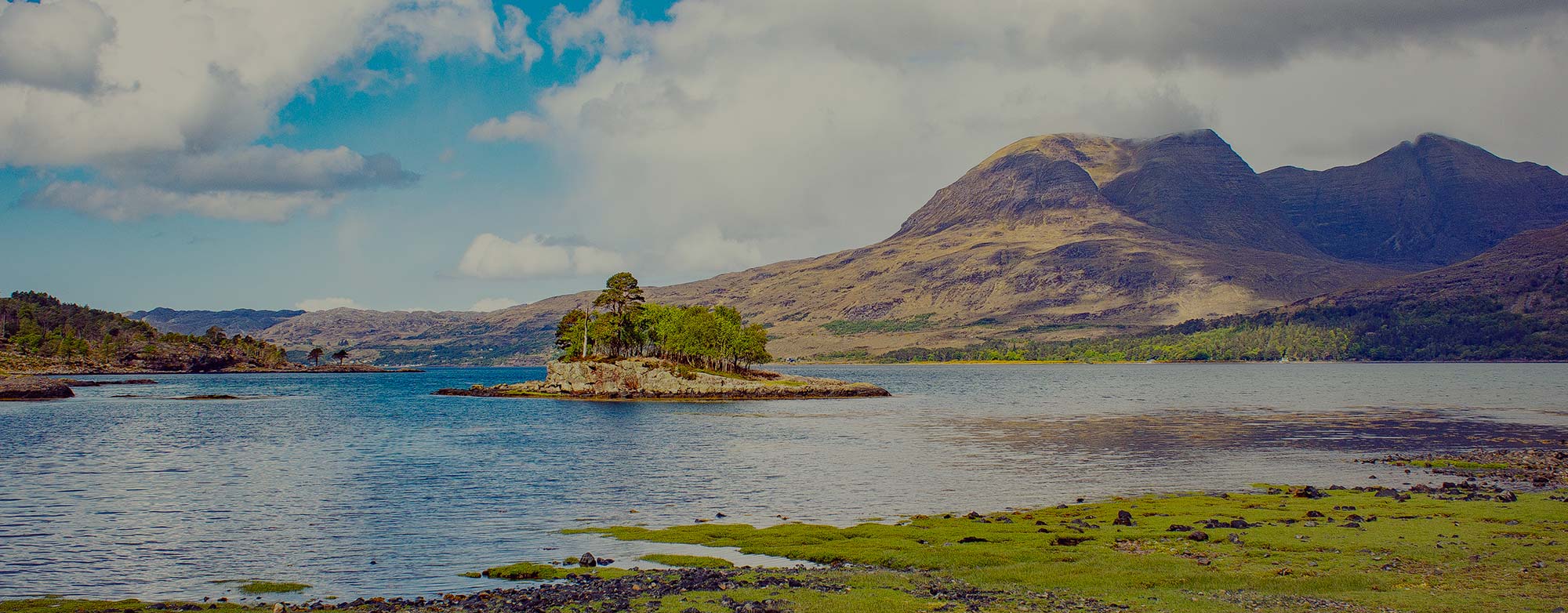
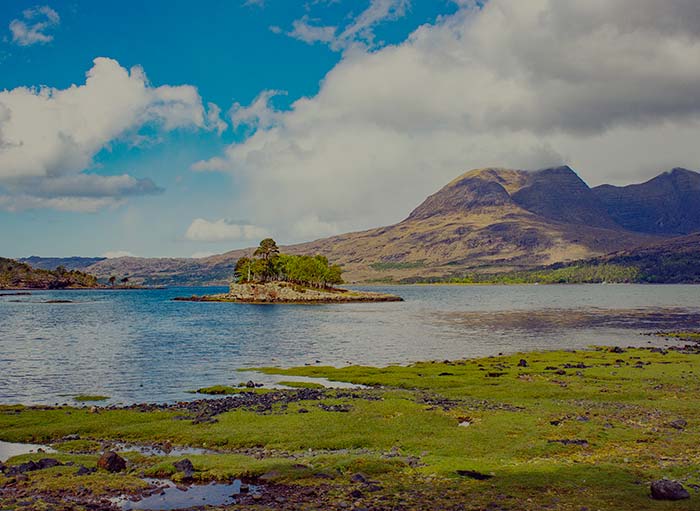


The geography of Scotland is bold and beautiful with stories and history to match. Scotland is a country that provides four seasons in one day with a climate and weather that has shaped the landscape and people for thousands of years. North, South, East or West, every area of Scotland has its own unique landmarks, legends, stories and history. It’s little wonder then that many of Scotland’s gin makers and brand owners have looked to their local area for inspiration. Whether it’s the Scottish Gin in the bottle, the brand, the packaging, the people; Scotland’s gin makers and brand owners, in one way or another, are influenced and inspired by their local landscape, stories, history and legends.
Some capture this idea of place in their gins with locally foraged botanicals that give a taste of rugged coastlines or heather covered hills. Some capture the notion of place in their packaging while others weave their own experiences of life in their local area into their brand. Scottish Gin not only captures the taste buds, but captures the imagination. In our Scottish Gin Geography editorial series, we look at some of the local landscapes, landmarks, characters and history that have inspired Scotland’s gin makers and brand owners.
Fidra Gin, North Berwick, East Lothian
North Berwick is a coastal seaside town in East Lothian just a short drive from Scotland’s capital city of Edinburgh. Boasting sandy beaches along with golf courses, independent shops and cafes, restaurants and a range of accommodation, the town of North Berwick is a popular attraction for visitors.
The town’s name is derived from the Old English for barley and farmstead. The name is also said to be partly derived from Old Norse, and like other places in Scotland that end with ‘wick’ meaning ‘bay’, the area features a number of bays and sheltered coves. Rich in archaeology, various excavations have revealed the area’s past with a settlement and agricultural field system dating back over 2000 years. There’s also evidence of a ferry crossing to Earlsferry in Fife estimated to be from the eighth century that was used to ferry pilgrims on their way to the shrine of Saint Andrew.
There are a number of islands dotted off the coast including Lamb, Craigleith and Bass Rock, which are home to a thriving sea colony of sea birds including puffins and gannets. And of course there is the island of Fidra. Fidra sits two and half miles off the coast of North Berwick and is currently an RSPB Scotland reserve. The island is the result of volcanic activity around 335 million years ago.
The island of Fidra features the ruins of an old chapel along with a working lighthouse that was built in 1885 and designed by David Alan Stevenson with the work supervised by his uncle Thomas Stevenson, a famous Scottish civil engineer. The last lighthouse keeper left in 1970 when the lighthouse became fully automated, becoming the first lighthouse in Scotland to be unmanned.
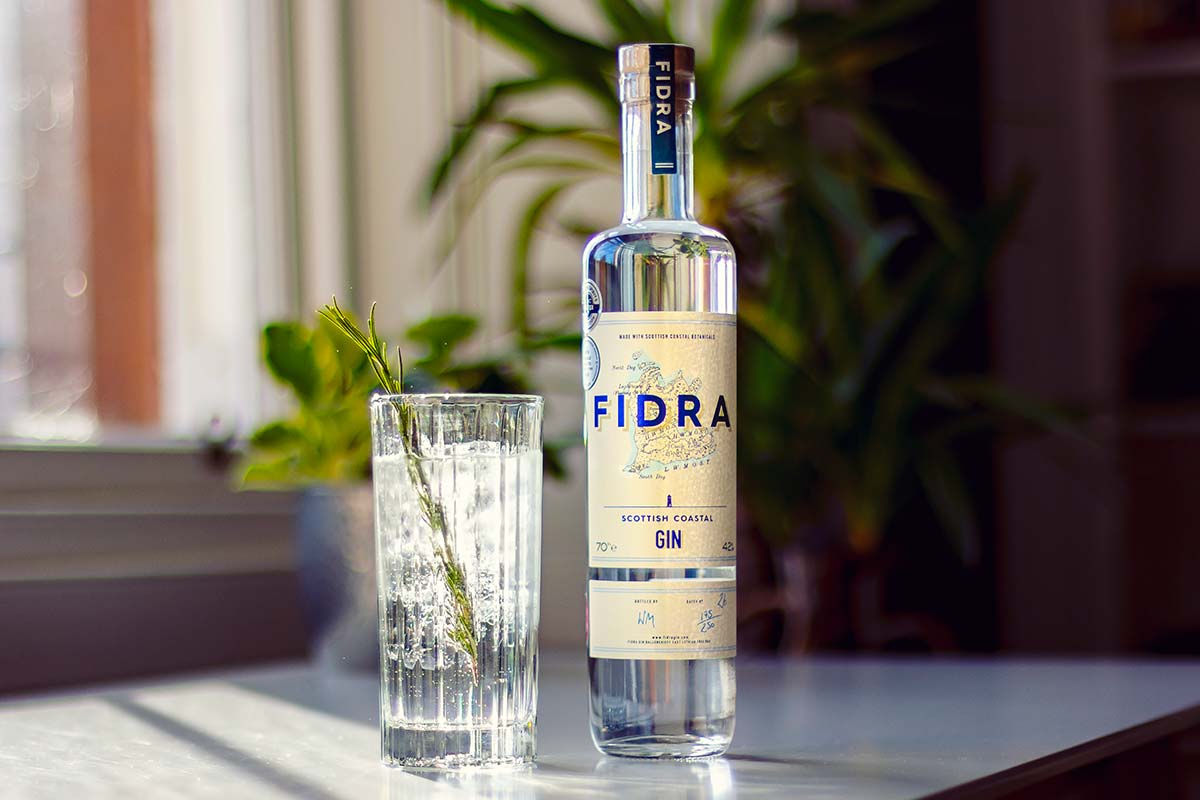 Fidra Gin takes both its name and inspiration from the island of Fidra. (Pic: ©The Gin Cooperative)
Fidra Gin takes both its name and inspiration from the island of Fidra. (Pic: ©The Gin Cooperative)
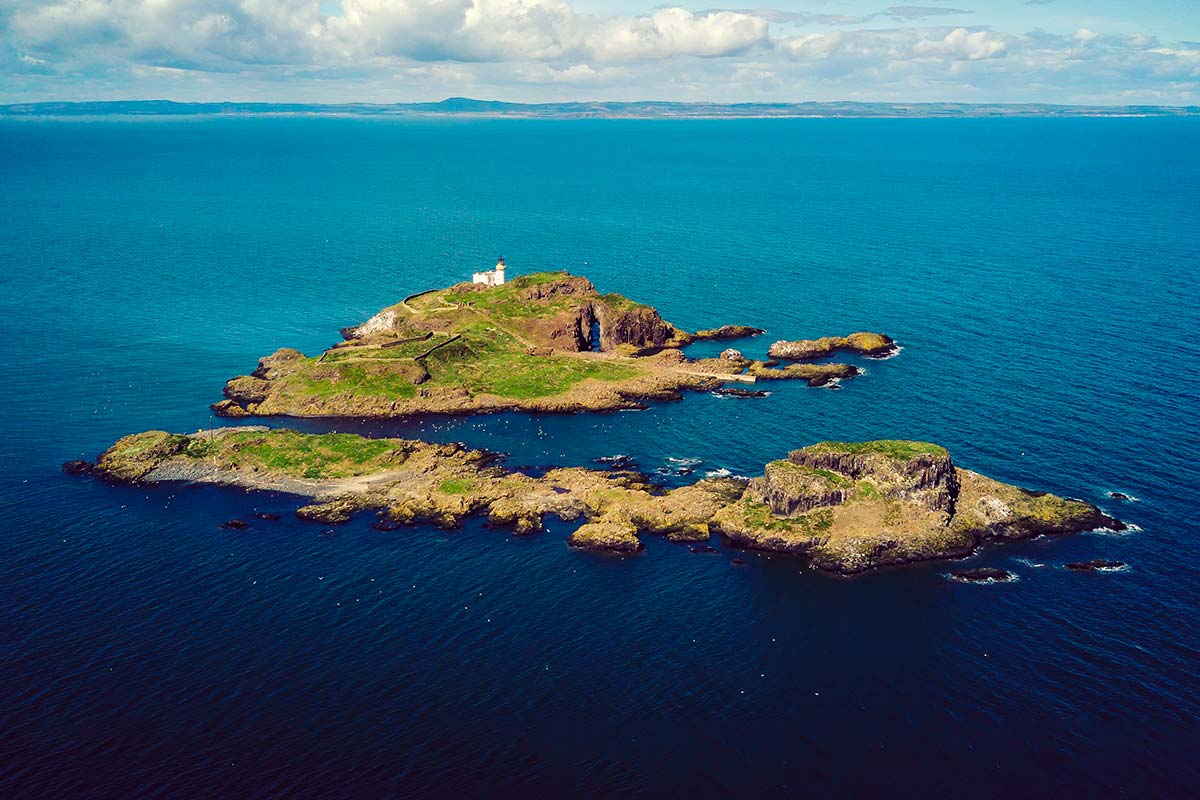 The island of Fidra is said to have inspired writer Robert Louis Stevenson and Treasure Island. (Pic: Used under licence)
The island of Fidra is said to have inspired writer Robert Louis Stevenson and Treasure Island. (Pic: Used under licence)
“We launched Fidra Gin in September 2018, naming it after the tiny but beautiful island of Fidra, just off the coast of North Berwick in East Lothian, where myself and co-founder Jo both live.
“Fidra island may not be that well known, even just 20 miles away in Edinburgh, but it is a real landmark here in East Lothian with a rich history of gin smuggling in the 1800s and its connection to Robert Louis Stevenson and Treasure Island, which is widely thought to have been inspired by Fidra itself. We wanted our gin to have a coastal feel and taste to it and be firmly rooted in East Lothian, so naming it after one of the county’s most well known seaside landmarks seemed like a no-brainer.
“We locally forage or grow most of the botanicals used in the making of our gin. The vibrant sea buckthorn berries, handpicked from our local sand dunes, provide a subtle salty tang – and the lemon thyme, grown at Archerfield Walled Garden overlooking Fidra itself, adds an aromatic and citrus touch.
“We have been lucky enough to gain a really strong local base of customers and we are very grateful to all our stockists who help increase exposure for our brand and generate sales. There are so many connections to Fidra among the local population with golf courses, streets, houses and even dogs named after the island and this definitely helps spike interest in our gin and increase sales. The island is also fully in view off the coast of Yellowcraigs, one of the most widely visited beaches in East Lothian. With a working Stevenson lighthouse on the island, lighting up the night sky, you are constantly reminded of Fidra (and hopefully of its gin!)”
Emma Bogulet, Co-Founder, Fidra Gin
Learn more about Fidra Gin here.
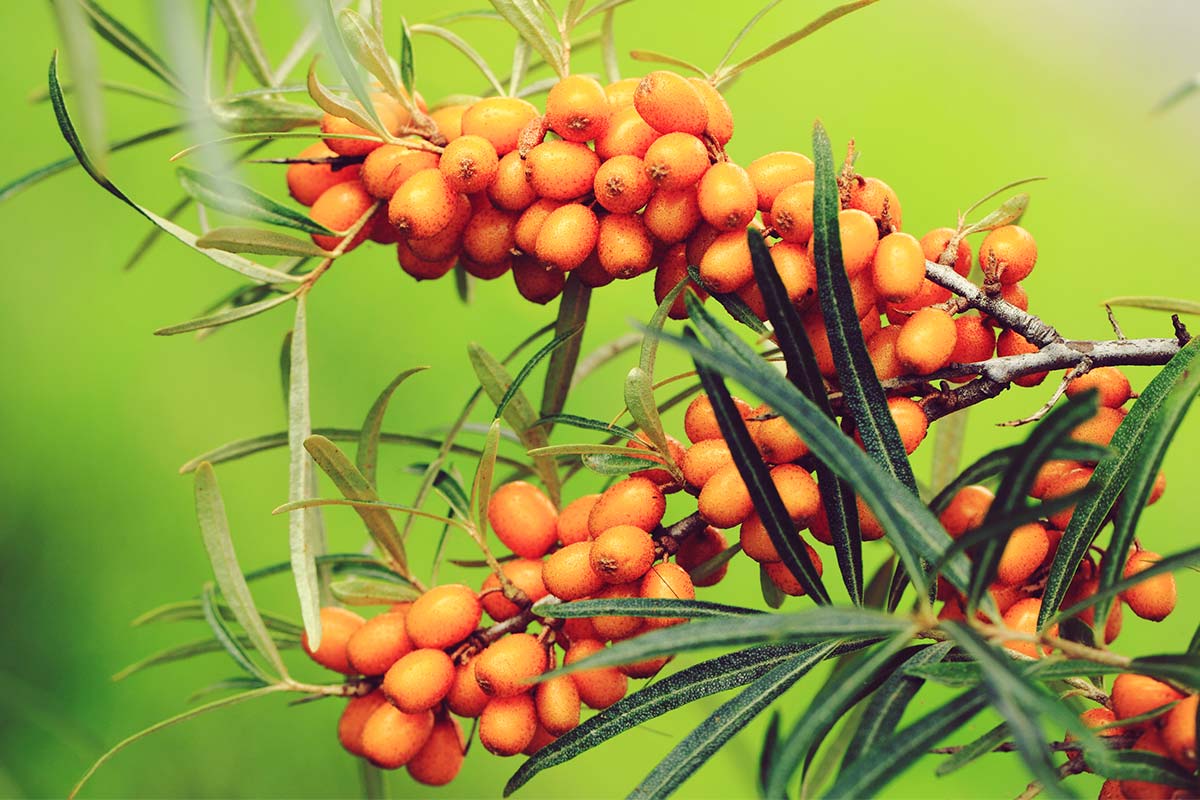 Some of the key botanicals in Fidra Gin include rosehips, elderflower, sea buckthorn (pictured) and lemon thyme. (Pic: Used under licence)
Some of the key botanicals in Fidra Gin include rosehips, elderflower, sea buckthorn (pictured) and lemon thyme. (Pic: Used under licence)
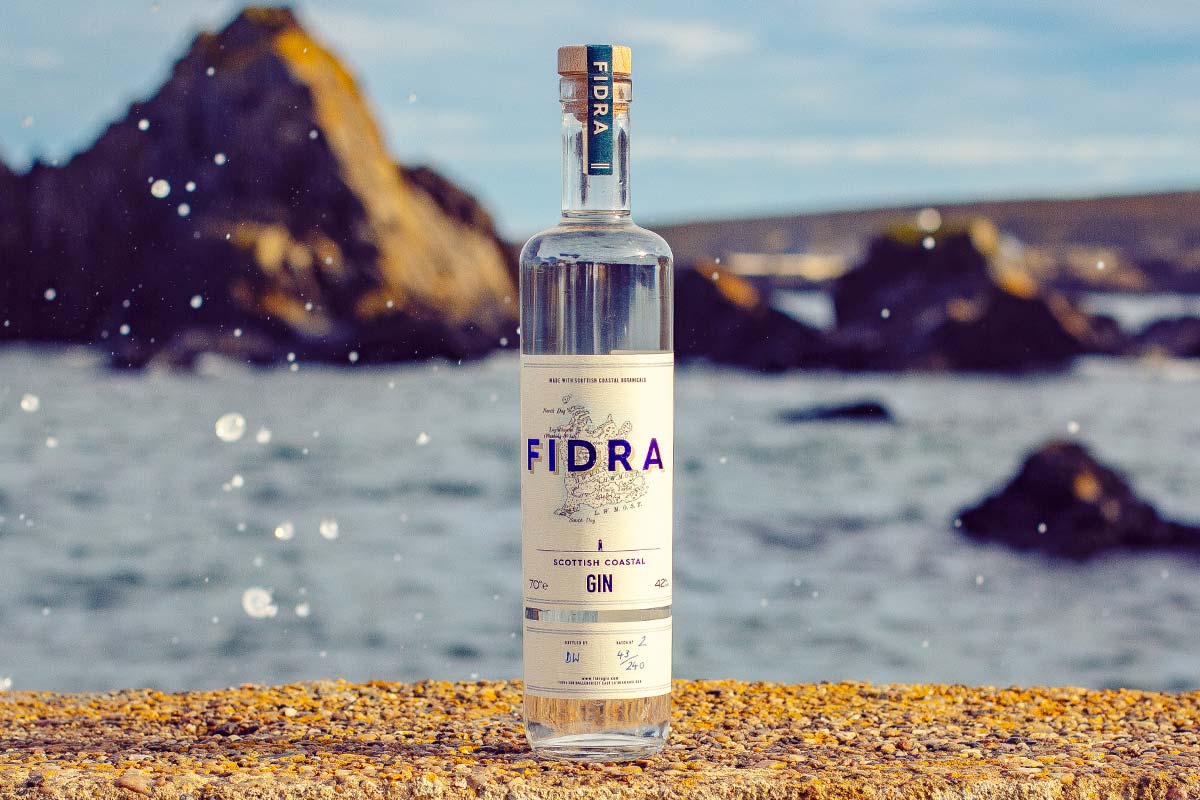 The Fidra Gin bottle features the lighthouse found on the island of Fidra, the first lighthouse in Scotland to be unmanned. (Pic: ©The Gin Cooperative)
The Fidra Gin bottle features the lighthouse found on the island of Fidra, the first lighthouse in Scotland to be unmanned. (Pic: ©The Gin Cooperative)
Pickering’s Gin, Edinburgh, City of Edinburgh
Edinburgh is world famous for many things including its castle, Hogmanay street party, Fringe festival… the list is extensive and varied. Recognised as Scotland’s capital city since the 15th century, Edinburgh is located on the southern shore of the Firth of Forth, an estuary which is fed by several rivers that include the river Forth before it meets the North Sea.
With its easy access to the north and various hills, the area proved a natural selection for habitation with the earliest archaeological evidence revealing a Mesolithic camp site at Cramond, a small fishing village North West of Edinburgh, dating back to 8500BC. A number of other settlements have been discovered over the years including Arthur’s Seat and Castle Rock, which is the site of Edinburgh Castle, the Pentland Hills and more.
With its coastal location, a number of ports appeared as the city continued to grow over the centuries with the Port of Leith providing a gateway for goods from around the world along with exports from across Scotland leaving for foreign shores. And as the population grew, so did the city. New industries grew to meet the growing need of the world including textiles, printing and of course brewing and distilling.
The city went through a sustained period of growth in the 19th century as the original Old Town, including the tenements along the Royal Mile and the Cowgate, which can still be seen today, led to overcrowding and cramped conditions resulting in poor sanitary and a high number of deaths due to illness. Construction of the New Town in 1767 saw new investment and growth for the city. It also saw new suburbs including Bruntsfield, Dalry and Marchmont appear.
Museums, libraries and galleries also began popping up as the level of investment in the city continued, attracting businesses and affluent business owners to the city. Along with the economic and social developments across the city, Edinburgh’s educational institutes also played a role in helping cement Edinburgh’s reputation for enlightenment, boasting three universities.
The University of Edinburgh was established by the Royal Charter in 1583, making it the forth oldest university in Scotland. Herriot-Watt University was established in 1821 and houses the International Centre for Brewing and Distilling, a research and teaching facility that specialises in the science and craft of brewing and distillation, along with providing industry research programmes.
Along with the universities and a number of colleges, Edinburgh has a rich educational heritage, with a number of world changing discoveries made by professors and students, along with cultural, economic and art movements that have helped play a role in shaping the modern world. Medicine, science, engineering, economics, the arts – the list is long. So it comes as no surprise that one of the oldest veterinary schools in the world now houses a Scottish Gin distillery.
Founded in 1823 by William Dick and located in a courtyard in Clyde Street in the Georgian New Town of Edinburgh, The Royal (Dick) School of Veterinary Studies was Scotland’s first school dedicated to the study and welfare of animals. William was a graduate of the Royal Veterinary College, London and returned to Edinburgh in 1818 with his veterinary diploma. By 1837, William’s reputation and standing in the world of veterinary studies grew and saw him appointed ‘Veterinary Surgeon to the Queen in Scotland’. In 1840, the school changed its name to Veterinary College with the approval of the Directors of the Highland Society.
The school would remain at the Clyde Street site up until it moved to Summerhall in 1906 and in 1951, the college became part of the University of Edinburgh. Although the college had a long history of collaboration and sharing academic resources with the the University of Edinburgh, up until 1951, the college had always stood as its own institution. It was a working college right up until 2011 before the faculty and students moved to a new purpose built hub on the Easter Bush campus.
In the heart of Edinburgh, nestled in the old dog kennels of the Old Royal Dick Vet School, you will find the home of Pickering’s Gin at Summerhall Distillery. It was founded as the first exclusive gin distillery in Edinburgh for over 150 years by Marcus Pickering and Matthew Gammell.
Matt and Marcus were both working at Summerhall when they spotted the derelict dog kennels from the animal hospital that once stood there. As fate would have it, Marcus had already inherited a gin recipe from a friend of his late father. With their mutual penchant for a good gin, the next step seemed obvious.
Matt and Marcus rolled up their sleeves and built the distillery themselves. Never mind that they had no background in distilling, Matt and Marcus tried, tested and experimented until they were experts. And so began the story of the Botanical Engineers.
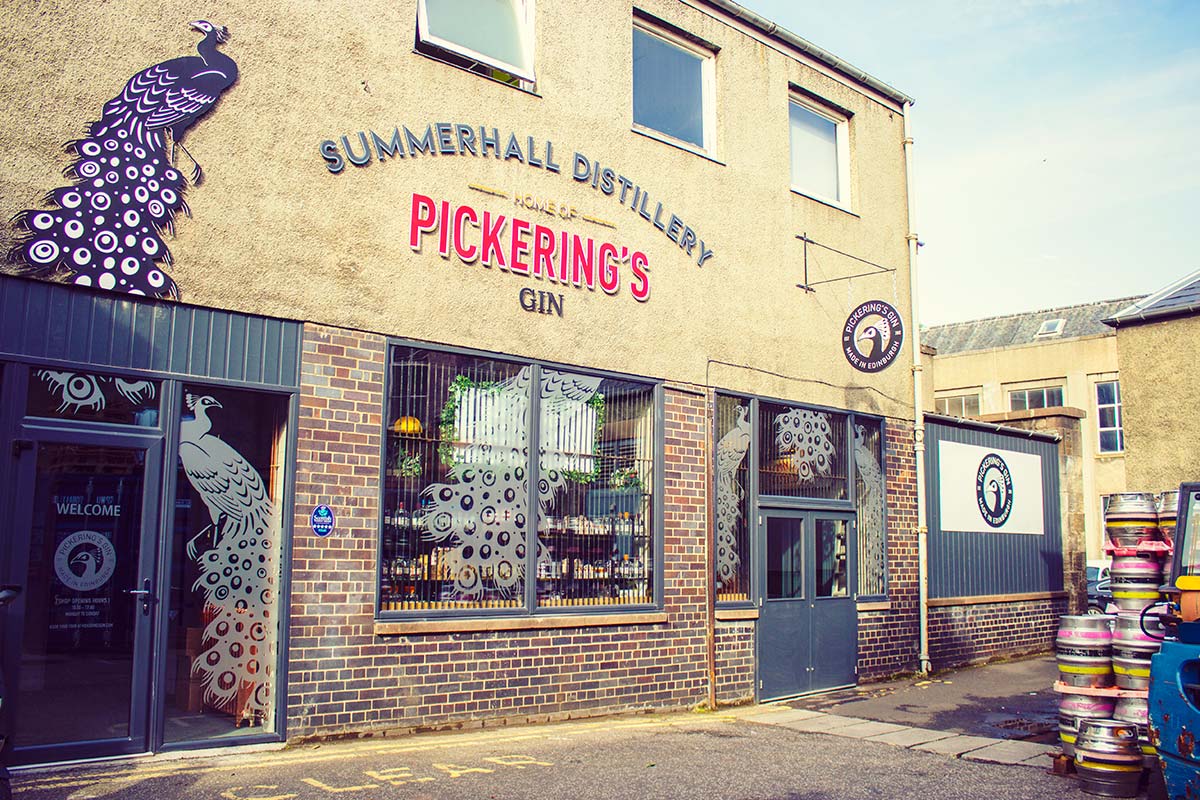 Summerhall Distillery, the home of Pickering’s Gin is located in the Old Royal Dick Vet School dog kennels. (Pic: ©The Gin Cooperative)
Summerhall Distillery, the home of Pickering’s Gin is located in the Old Royal Dick Vet School dog kennels. (Pic: ©The Gin Cooperative)
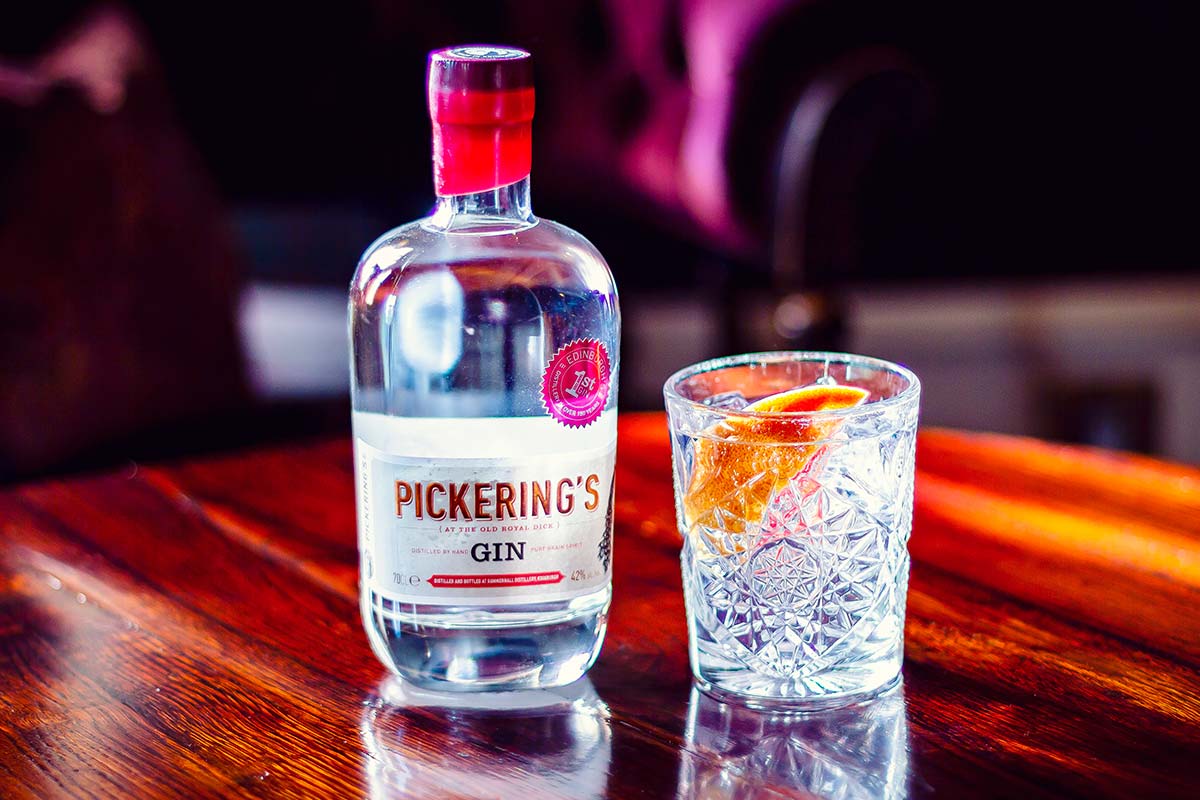 Pickering’s Gin, the signature expression from Summerhall Distillery. (Pic: ©The Gin Cooperative)
Pickering’s Gin, the signature expression from Summerhall Distillery. (Pic: ©The Gin Cooperative)
“Edinburgh has some of the most dramatic landscapes in the world, let alone Scotland. From the coastline to the crags and the seven hills of Edinburgh, one can enjoy the history and beauty of Edinburgh all at the same time! Summerhall Distillery can be found just a stone’s throw from one of Edinburgh’s seven hills, Arthur’s Seat, an ancient volcano that sits 251m above sea level. We are surrounded by an abundance of Scottish plants and botanicals that became the inspiration behind the flavours of some of Pickering’s Gin products, including Pickering’s Gin with Scottish Botanicals. Water is another fundamental element to our distilling process, which comes directly from Glencorse Reservoir in the Pentland Hills (another one of Edinburgh’s Seven Hills). Before cutting the spirit with water, it goes through a 3-stage particulate filter ensuring the purest of Scottish water.
“The history of distilling in Edinburgh means everything to us, especially since distilling, blending and bottling has been around since the 1700s. Therefore, restoring gin distilling back to Edinburgh was so important. Summerhall Distillery is now encased by 12 distilleries in Edinburgh so we were extremely proud to be the first gin distillery in Edinburgh for over 150 years.
“Going back to the geographical area at Summerhall, the wall of our bottling room is actually the last remaining part of an old brewery that was once based here in Summerhall. MacMillian & Co Brewers were brewing onsite from the late 1800s to the early 1930s. Our distillery really is surrounded by history and legendary stories that are crucial to the ‘home’ of our gin. It’s our aim to maintain that legacy through our products and production here at Summerhall Distillery!”
Marcus Pickering, Co-Founder, Summerhall Distillery
Learn more about Pickering’s Gin here.
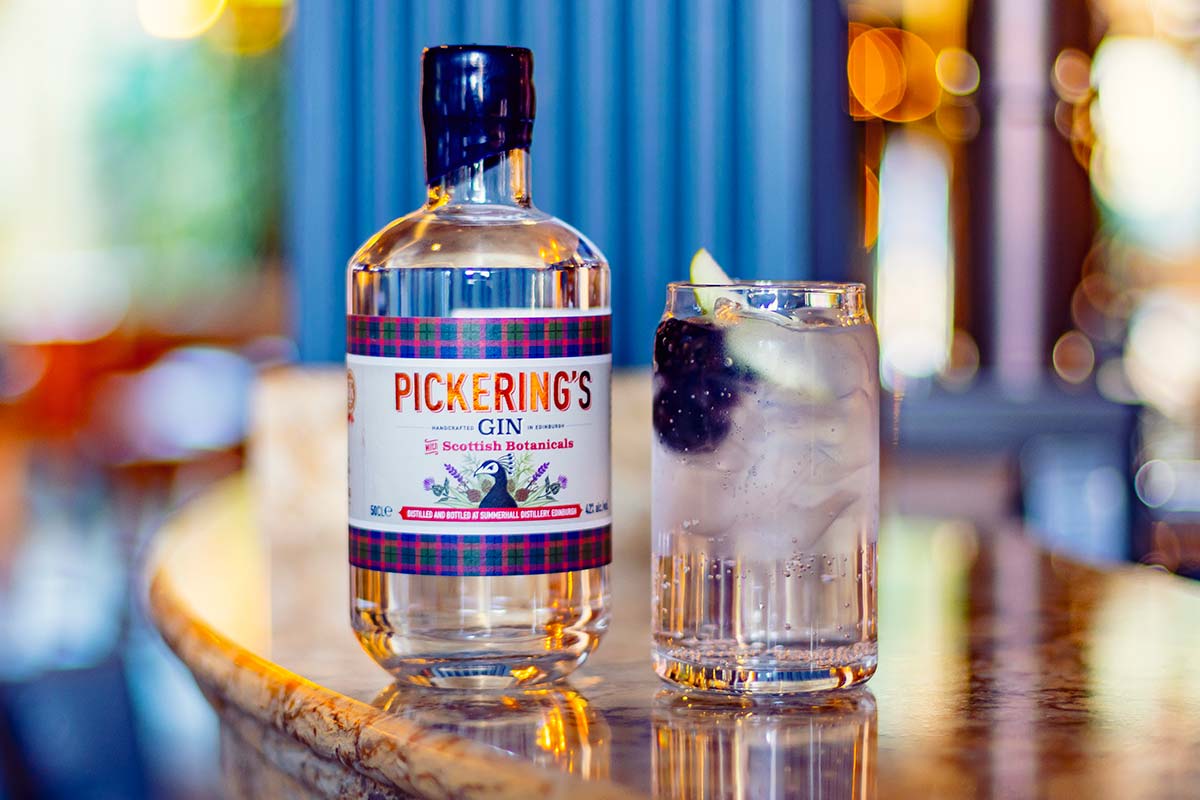 Pickering’s Gin with Scottish Botanicals, created using a variety of local botanicals. (Pic: ©The Gin Cooperative)
Pickering’s Gin with Scottish Botanicals, created using a variety of local botanicals. (Pic: ©The Gin Cooperative)
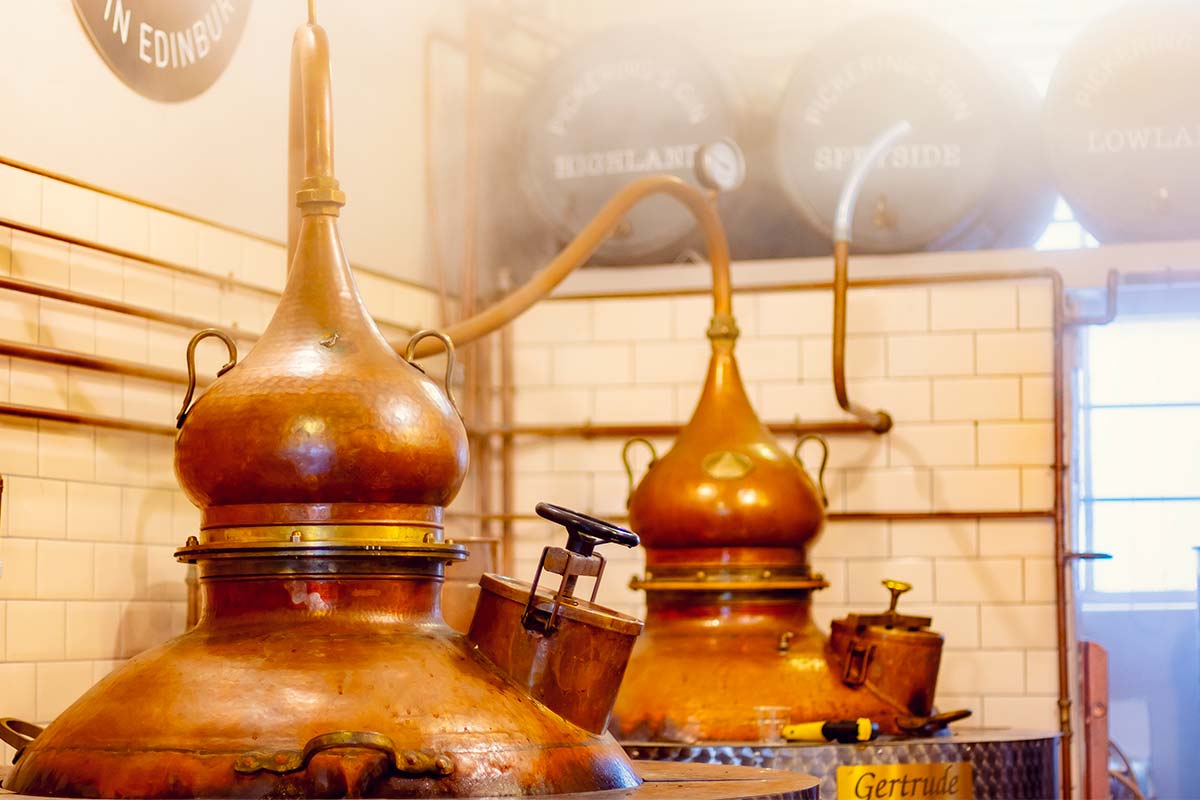 The distillery room at Summerhall Distillery features two copper alembic stills, Emily and Gertrude, which are heated via custom designed water baths. (Pic: ©The Gin Cooperative)
The distillery room at Summerhall Distillery features two copper alembic stills, Emily and Gertrude, which are heated via custom designed water baths. (Pic: ©The Gin Cooperative)
Arcturus Torridon Gin, Torridon, Highland
Torridon is located in the North West Highlands of Scotland, nestling the coast and some of the most stunning mountain scapes to be found anywhere in the UK. The landscape was formed over 2500 million years ago with the red sandstone forming some of the oldest rocks in the world. The tops of the mountains are mostly capped with quartzite, which shines a brilliant white in sunlight giving the impression that the mountains are capped with snow all year round. The area comprises a number of settlements including the villages of Torridon, which sits at the top of Upper Loch Torridon, Annat, Sheieldaig, Inver Alligin, Applecross and Kinlochewe.
The name Torridon is derived from Scots Gaelic meaning ‘a place of transference’ symbolising the way the landscape and location moves from sea loch, to land and mountain, to valley and leading to other landlocked bodies of water. The area is no stranger to distilling, with a number of caves and hidden spots used for the purposes of making illicit whisky and spirits, including the Smuggler’s Cave, a cleft in the rock on the Torridon Estate that was used to evade the landowner and excisemen.
The Torridon Hotel sits on the Beinn Damh Estate beside the small settlement of Annat, the village on the estate which was home to the estate’s workers and home to the Annat Skull. The folklore goes that the skull belonged to a women surname Grant who took her own life in the eighteenth century. Because of her demise, a burial on holy ground was forbidden so she was laid to rest on the outside of the churchyard. Her skull would rise from the earth and would act as a talisman for curing epilepsy. Unfortunately it meant drinking water from a specific fresh water spring from the skull whilst walking and reciting a number of incantations. It is said that the skull cured all who drank from it! Thankfully the skull was lost to history and the only drink that awaits visitors to the area involve a Arcturus Gin and tonic!
The hotel was originally Beinn Damh House, which was commissioned by William King-Noel, the first Earl of Lovelace in 1860 and completed by 1887. Built as a hunting lodge to accommodate family and guests, the materials for the building were shipped in via the sea loch as access via the old single track path made shipping the heavy materials by horse and cart impossible, with soil for the kitchen garden shipped in from Ireland. The house was completed in the 50th year of Queen Victoria’s reign and to mark this historical moment in time, there are a number of adornments and decorations dotted around the house that mark the date. The area was also no stranger to royalty, with Queen Victoria regularly visiting the area with her personal servant John Brown.
In the early 1960s, the house was sold and converted into a hotel, which was managed by the Lovelace family and renamed the Torridon House. It changed ownership over the years before the hotel was bought by David and Geraldine Gregory in 1992. In 1993, it was re-opened as The Loch Torridon Country House Hotel before eventually being taken over by the Gregory’s daughter Rohaise and son-in-law Dan. Throughout this time, from 1992 to present, the family have focused on carefully and tastefully restoring, renovating and preserving the heart and soul of the building whilst continuing to push forward the concept of world class highland hospitality.
With investment in the kitchen gardens, creation of Arcturus Gin and a lot of hard work, the current owners Dan and Rohaise Rose-Bristow have created a luxury venue known for its service, food and drink offering and untamed and unspoilt landscape, having picked up numerous recognitions including Scottish Hotel of the Year, Best Hotel In Scotland, Scottish Activity Hotel of the Year, Icon of Whisky for its whisky bar and the hotel’s 1887 Restaurant awarded AA 3 Rosettes.
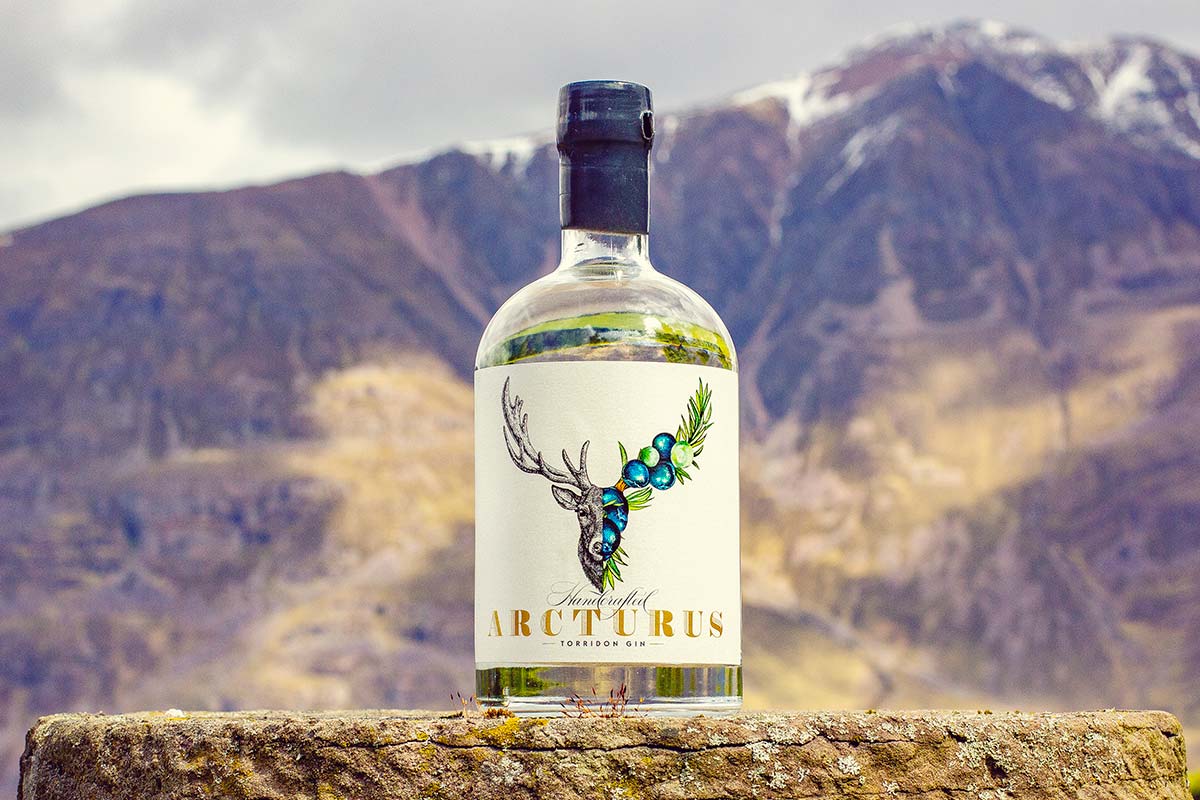 The signature Arcturus Original Gin pictured in front of Mullach an Rathain (Liathach), one of the many 3000ft plus Munros in the area. (Pic: ©The Gin Cooperative)
The signature Arcturus Original Gin pictured in front of Mullach an Rathain (Liathach), one of the many 3000ft plus Munros in the area. (Pic: ©The Gin Cooperative)
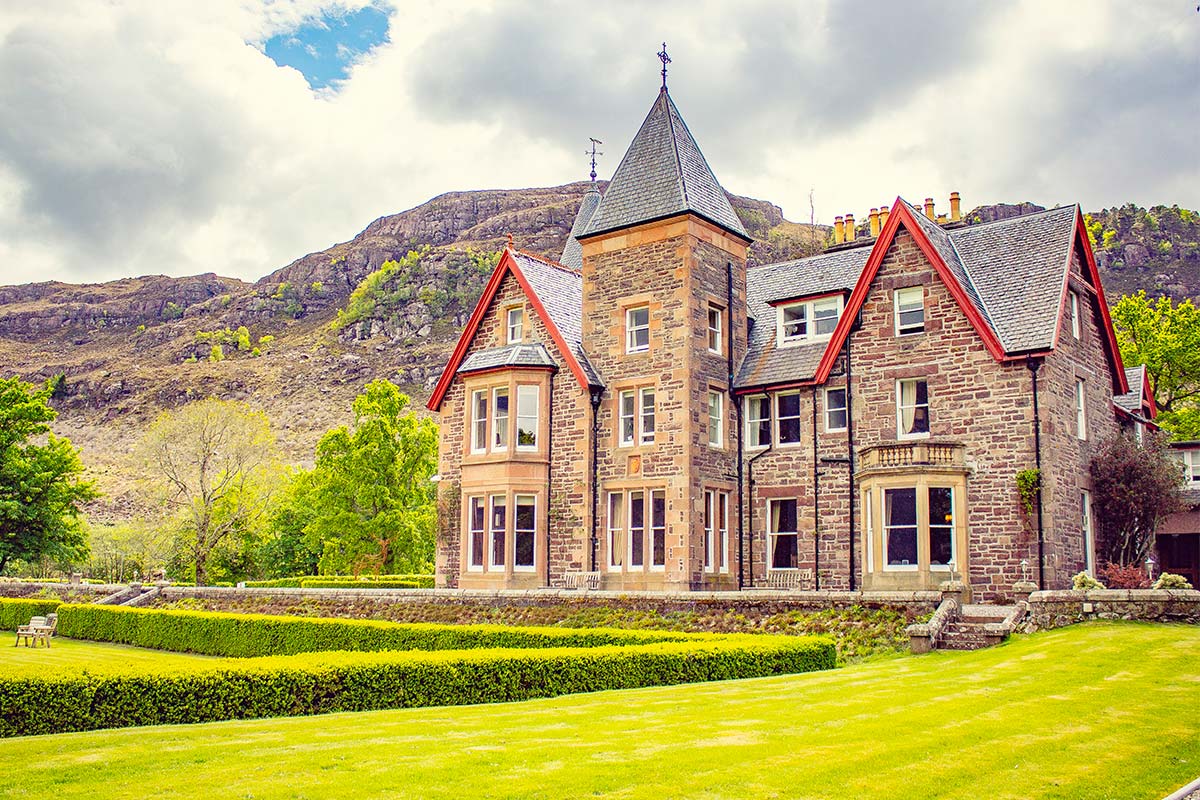 The Torridon Hotel was originally built as a hunting lodge and completed in 1887. (Pic: ©The Gin Cooperative)
The Torridon Hotel was originally built as a hunting lodge and completed in 1887. (Pic: ©The Gin Cooperative)
“Set in 58 acres of parkland at the end of a magnificent sea loch, The Torridon has one of the most spectacular and idyllic locations in the country. The resort offers something for everyone. Perhaps you yearn for a reviving outdoor escape, or simply a relaxing holiday pampered in a luxury hotel, or getting out of your muddy walking boots and sitting by a crackling fire in a welcoming pub. Our aim is to deliver each guest their own unforgettable experience and our Arcturus Gin is an extension of this ethos.
“Named for first-magnitude star in the constellation of Boötes, Arcturus is among the brightest stars that can be seen from Earth and is related to the stag. Stags are prominent figures in Torridon and are creatures of beauty. Arcturus is inextricably connected to the Torridon landscape, born from the land, mountains and sea surrounding the resort, our Torridon gin is handcrafted and locally foraged. We blend a range of botanicals together with pure Scottish Loch water to produce three beautifully delectable gins; Arcturus Torridon Gin Original Edition, Arcturus Torridon Gin Scots Pine Edition and Arcturus Torridon Gin Sloe Gin Edition.
“Our first original gin was conceived from foraging local highland botanicals including Scots Lovage from our own two-acre kitchen garden, foraged Bilberries and Rowanberries from the mountains beyond and Kelp Seaweed from Loch Torridon’s shore. It’s blended with pure Scottish loch water and distilled in small batches to an aromatic, crisp, clean gin with a dry finish.”
Dan Rose-Bristow, Co-Founder, Arcturus Torridon Gin
Learn more about Arcturus Torridon Gin here.
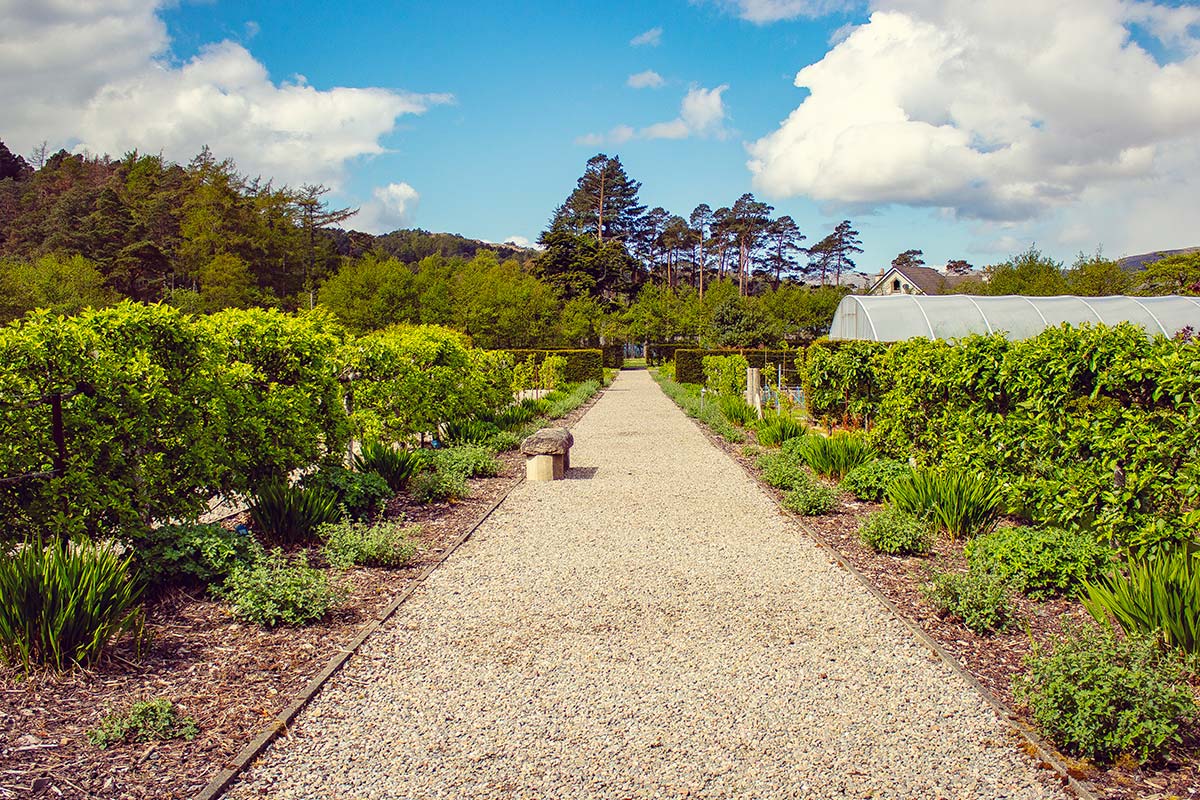 The Torridon Hotel gin and kitchen garden features a range of plants that appear in both the food served at the hotel and Arcturus range of Scottish Gins. (Pic: ©The Gin Cooperative)
The Torridon Hotel gin and kitchen garden features a range of plants that appear in both the food served at the hotel and Arcturus range of Scottish Gins. (Pic: ©The Gin Cooperative)
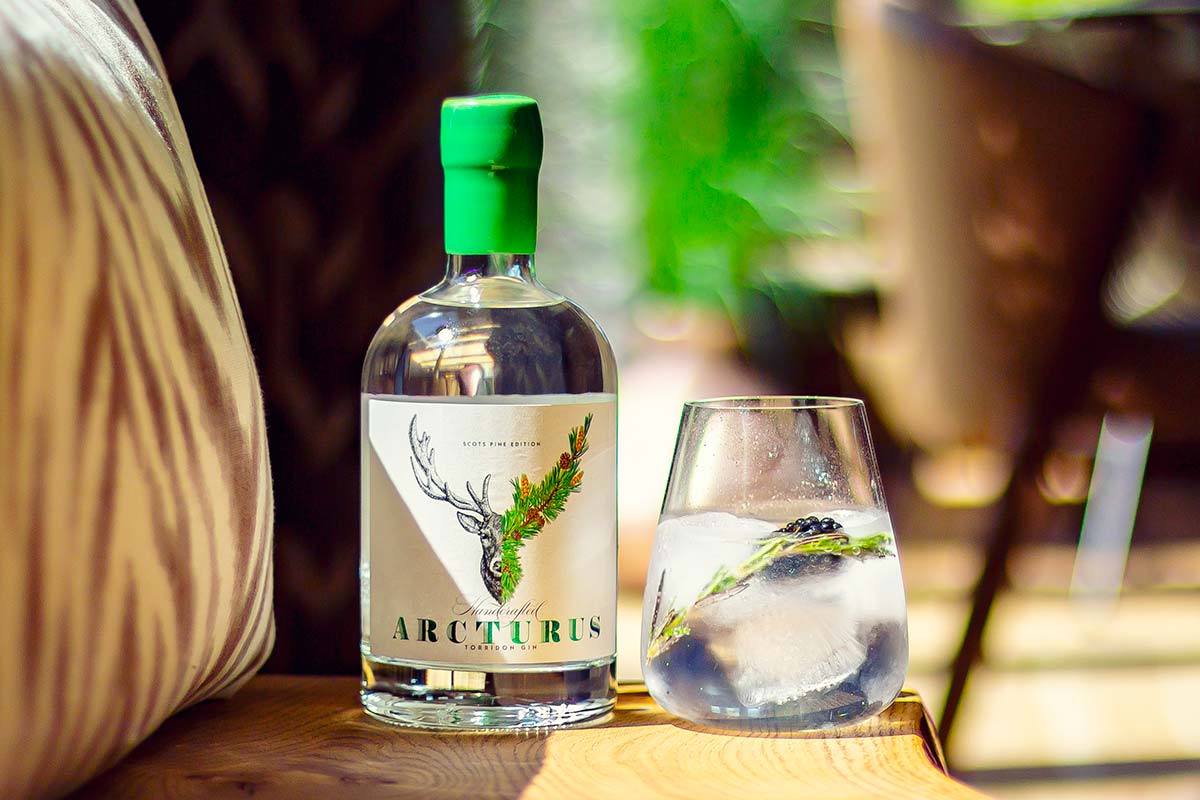 The second release from the team at The Torridon Hotel, Arcturus Torridon Gin Scots Pine Edition. (Pic: ©The Gin Cooperative)
The second release from the team at The Torridon Hotel, Arcturus Torridon Gin Scots Pine Edition. (Pic: ©The Gin Cooperative)
Lost Loch Spirits, Aboyne, Aberdeenshire
Located on the outskirts of Aboyne, which was founded in 1671 by Charles Gordon, 1st Earl of Aboyne, the Lost Loch Spirits distillery is surrounded by history. With rolling farmland, an abundance of fresh water and just a short distance from the edge of the Cairngorm’s National Park; nature, history and inspiration are plentiful.
There are a number of historic sites in the area including the Formaston Stone, a Pictish stone cross inscribed with the names of Pictish Kings. The Knight’s Templar were given a charter of liberty to acquire land in Scotland by Alexander II in 1237, with the Knight’s Templar given preceptory of the church in Aboyne.
Glen Tanar is another well known and well loved area, which is a national nature reserve and forms part of the larger Cairngorm’s National Park. Golden Eagles, Red Deer, Pine Martin, Capercaillie along with a wide array of fauna make up the area, which is open to the public, providing hill walking routes and plenty of green space for adventure. Glen Tanar also has its own tales and history that have been passed down through local folklore. One such story is the story of the ‘Haunted Stag’.
In the 1870s, the Laird of Glen Tanar had been after an elusive stag for a number of years. The monarch stag, which boasted a set of 16 point antlers, was nicknamed the ‘Haunted Stag’, as any time the laird got near, it mysteriously vanished without sight or sound. The Laird had a gentlemen’s agreement with his head gamekeeper that whoever managed to track and shoot the stag would win a wager. However, upon their death, the loser would be buried with the antlers.
It was eventually in October 1877, as the Laird and his gamekeeper crested one of the hillsides on the estate, that the Haunted Stag appeared. As was agreed, the Laird raised his shotgun and took aim. From a distance of 81 meters the shot brought down the stag, which at the time was a remarkable distance. In tribute to the stag and their game of cat and mouse, the laird had two granite markers commissioned and placed on the site of the shot and where the stag fell.
To this day, the markers can still be seen if you’re prepared to make the walk. And as to where the antlers are now, as walkers follow the path up the hillside in Glen Tanar, they walk past the St Lesmo’s Church. It’s in this small humble graveyard where the stag’s antlers are said to rest, buried alongside the Laird’s gamekeeper.
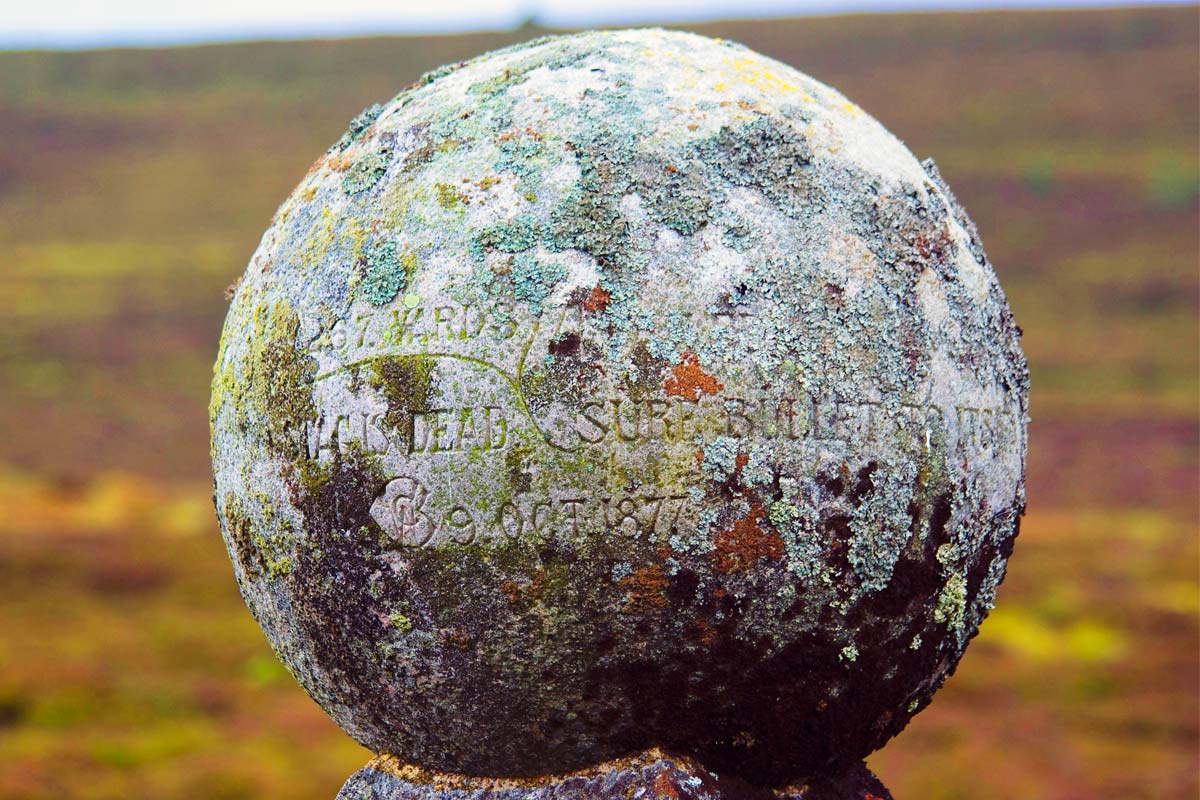 The markers were put in place in 1877 to mark the Haunted Stag. (Pic: ©The Gin Cooperative)
The markers were put in place in 1877 to mark the Haunted Stag. (Pic: ©The Gin Cooperative)
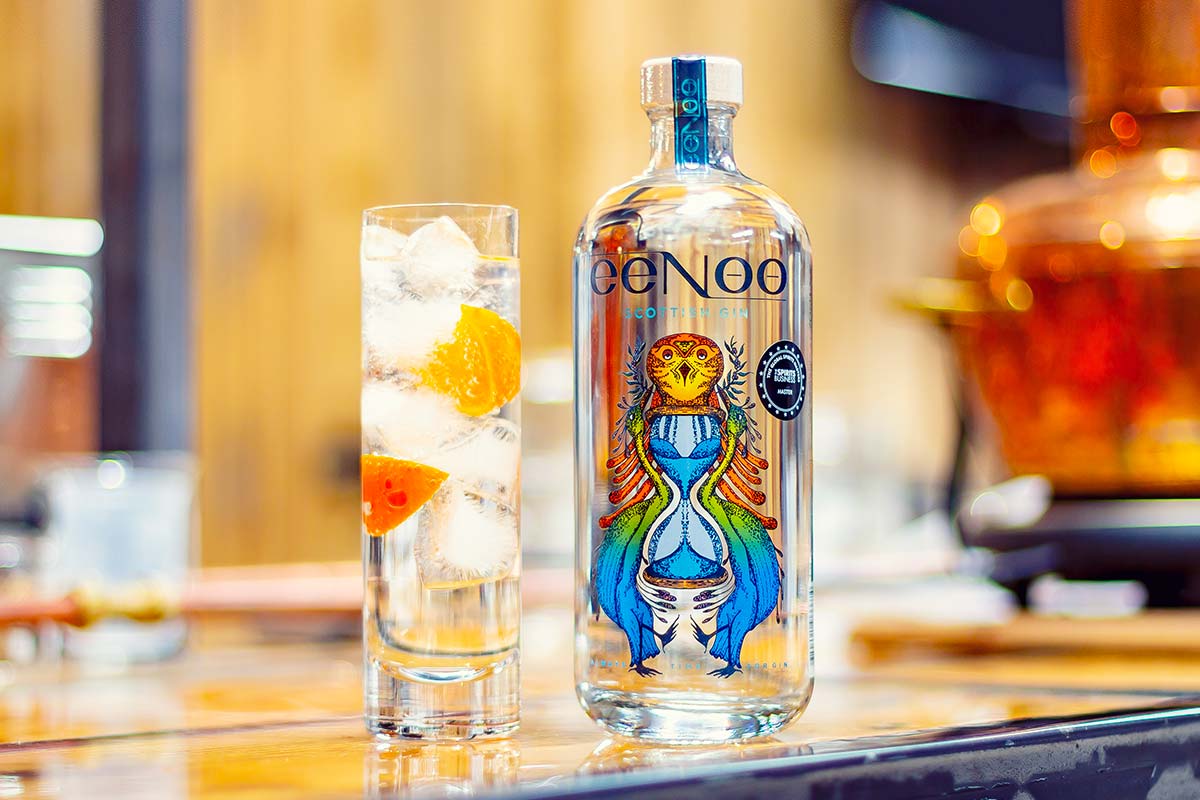 eeNoo Scottish Gin, distilled at the Lost Loch Spirits Distillery in Aberdeenshire. (Pic: ©The Gin Cooperative)
eeNoo Scottish Gin, distilled at the Lost Loch Spirits Distillery in Aberdeenshire. (Pic: ©The Gin Cooperative)
“Geography has played a massive part in who we are as a business. Being based on Royal Deeside; the landscape, its history and what grows here has influenced eeNoo Gin. The three most important elements of Lost Loch are the place, the process and the spirits. Even the name Lost Loch is inspired by the geography of the area. The distillery is built on the banks of the now drained Loch Auchlossan, or the Lost Loch. The landscape and the history surrounding us ultimately influence our storytelling, flavours and branding.
“When we created eeNoo, we wanted to use botanicals and flavours that surround us. The area is filled with juniper, raspberry, bramble and rosehip bushes and these botanical elements form the basis of eeNoo gin. To complement these flavours, we distil with Royal Deeside honey, which is a mixture of willow, clover and heather honey. The hives are located within 10 miles of the distillery and the honey is very unique to the Deeside area.
“The water used to make a gin is also very important as it makes around half of what goes into a bottle. We are lucky enough to have access to a spring in the Cairngorm mountains. The water has a natural purity on account of the geology of the region. It spends 50 years underground gently filtering through layers of rock before being added to eeNoo gin.”
Peter Dignan, Co-Founder, Lost Loch Spirits
Learn more about Lost Loch Spirits here.
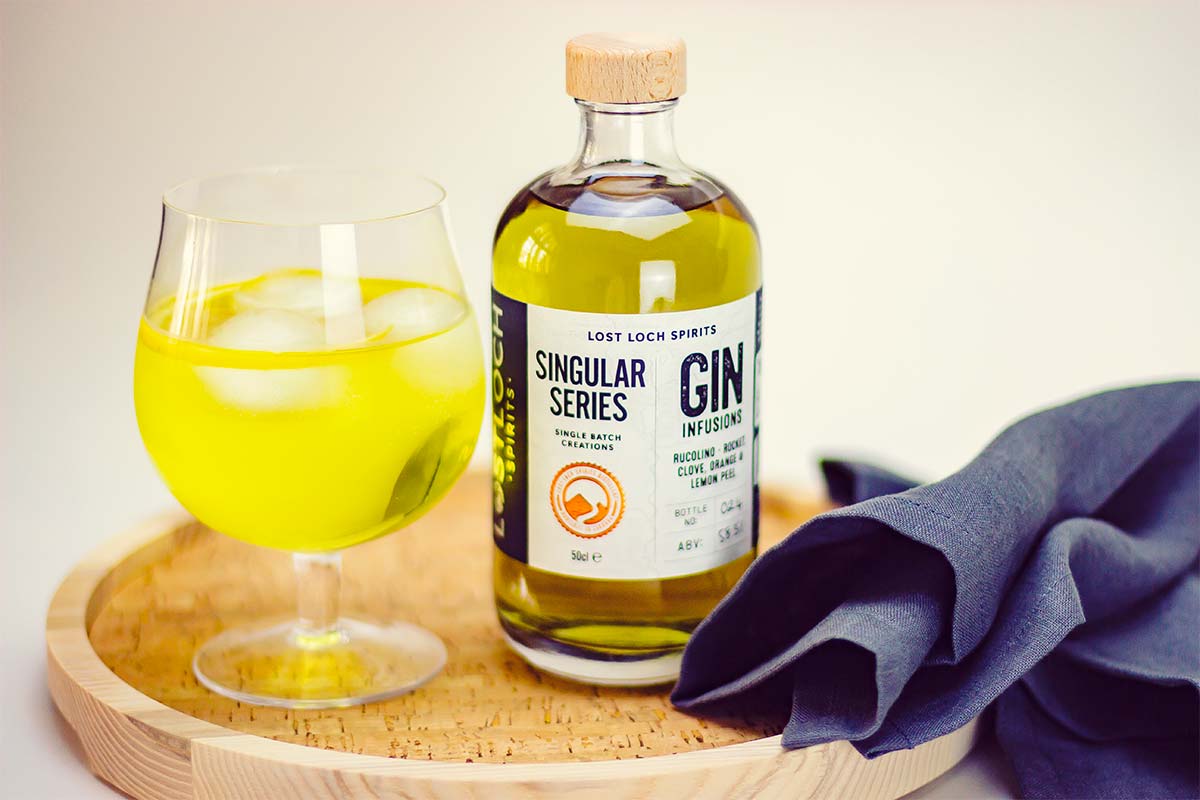 The Singular Series from Lost Loch Spirits is a range of experimental creations including gin, rum and absinthe. (Pic: ©The Gin Cooperative)
The Singular Series from Lost Loch Spirits is a range of experimental creations including gin, rum and absinthe. (Pic: ©The Gin Cooperative)
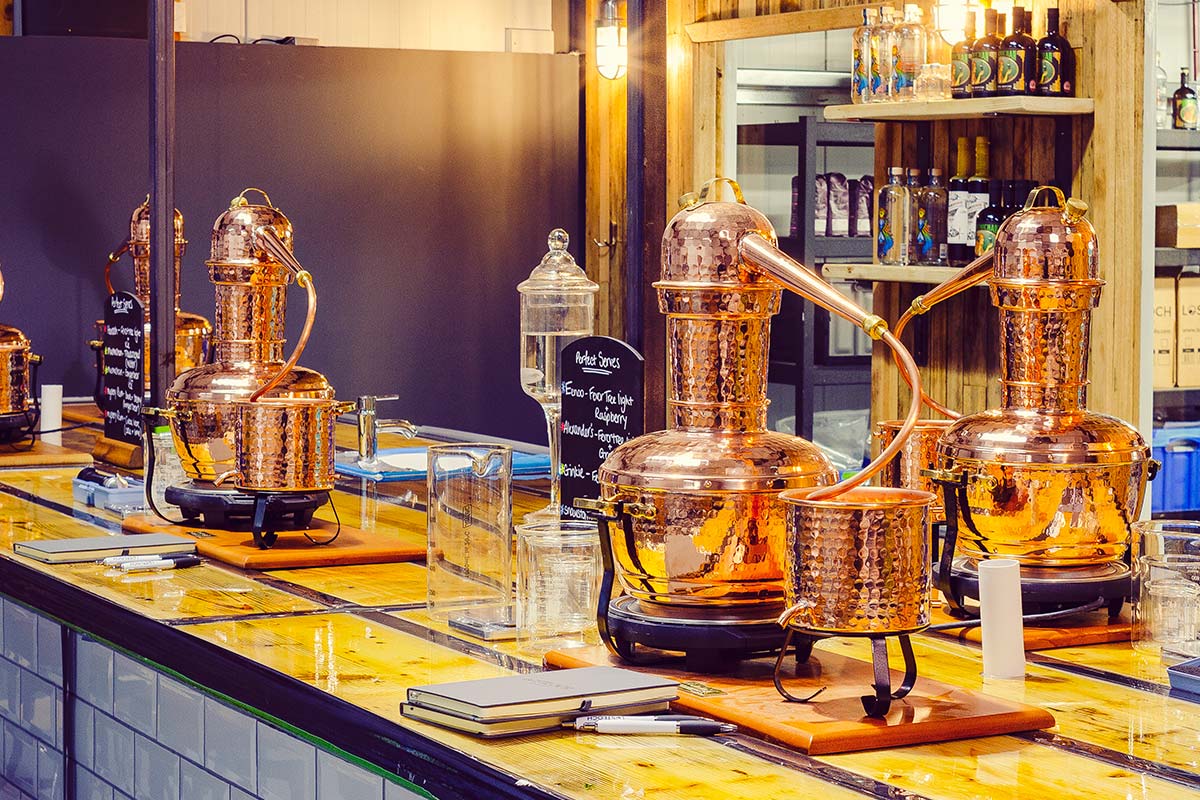 The Lost Loch Spirits Distillery features a gin and spirit school where visitors can distil their own spirits including gin or botanical rum. (Pic: ©The Gin Cooperative)
The Lost Loch Spirits Distillery features a gin and spirit school where visitors can distil their own spirits including gin or botanical rum. (Pic: ©The Gin Cooperative)
The Glasgow Distillery Company, Glasgow, Glasgow City
People make Glasgow. And Glasgow made the world. An industrial heartland for over a century, Glasgow and the shipyards along the Clyde built ships that sailed the world, including the QE 2, right up until the early 1980s, by which time the majority of shipyards had closed their doors for good.
Meaning ‘Green Glen’, Glasgow can trace its roots back to the arrival of St. Kentigern (Mungo) who established a religious community in the area. The current Glasgow Cathedral was dedicated to St Mungo with work beginning in the 12th century and was built on the former site of the chapel that was established by St Mungo. As the settlement grew, so did the population; with the building of the Cathedral and Glasgow designated a Royal Burgh in 1450, the University of Glasgow was established a year later. Thanks to its location between lowland Scotland and the Highlands, the city acted as a gateway for trade and commerce.
With its access to the Atlantic and sea trading routes to Europe and the rest of the world, Glasgow grew significantly, exporting and importing goods including tobacco, rum, sugar and textiles, which eventually led to the development of the river Clyde. The river had always played a role in transporting goods from the West coast to the city, but the growth in trade meant the river was eventually widened and dredged to make it more accessible for bigger ships.
The industrial revolution, which changed the face of Britain forever, also had an impact on Glasgow as factories sprung up producing goods along with processing imports brought in from around the world. Fast forward to modern Glasgow and you’ll find a city that’s culturally rich and diverse with engineering, science, manufacturing, publishing, media, digital, aerospace technology and more all forming a number of key business sectors that have all contributed to the revitalisation and growth of the city. And more recently the city has played host to Hollywood, acting as a backdrop for movies including World War Z and the soon to be released Batman starring Robert Pattison and Zoe Kravitz.
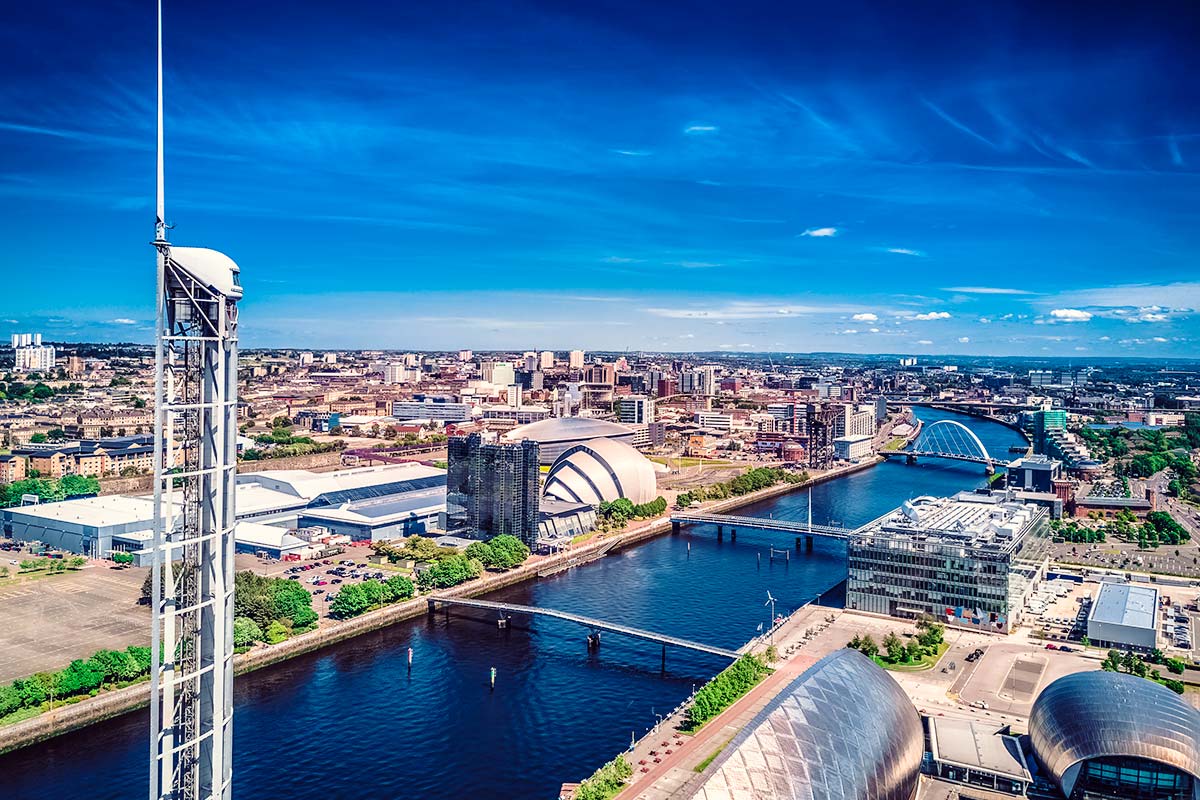 The Glasgow shipyards have undergone a sustained period of investment and reinvention. (Pic: Used under licence)
The Glasgow shipyards have undergone a sustained period of investment and reinvention. (Pic: Used under licence)
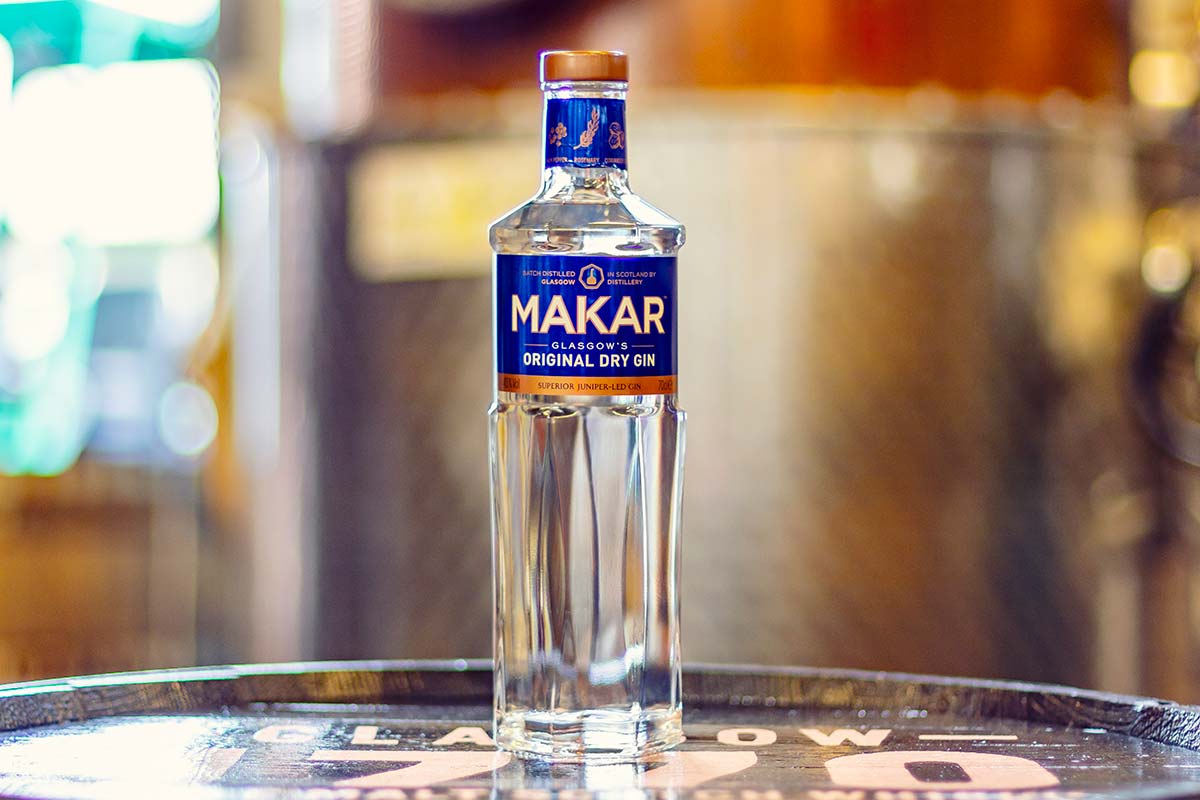 The Glasgow Distillery Company released its signature Makar Glasgow Original Dry Gin in 2014. (Pic: ©The Gin Cooperative)
The Glasgow Distillery Company released its signature Makar Glasgow Original Dry Gin in 2014. (Pic: ©The Gin Cooperative)
“At The Glasgow Distillery, we are informed by our industrial environment and heritage. Situated at the centre of a historic industrial estate, which was first built to manufacture fighter plane engines in the lead up to WW2, engineering, manufacturing and industry is very much at the roots of who we are. The industrial landscape within which we operate is reflected in how we communicate ourselves; we strive to be open and accessible with a high degree of importance placed on the values of authenticity and transparency – what you see is what you get.
“We are a small team but we work hard and strive for excellence in our craft. As an independent distillery, all our investment goes into making the best possible spirits we can. I like to think that for us the beauty lies within our bottles, not necessarily outside of them! We take our processes and quality control very seriously but try to approach the rest of our job with humility and a sense of fun.
“It’s no surprise, therefore, that the products we produce are all influenced by this notion of industry. Makar Gin was the first product we released back in 2014, and the bottle design is very much a reflection of our city. The tall angular bottle is reminiscent of Glasgow’s art deco architecture and the crisp sharp angles are reflective of our industrial surroundings. The bespoke bottle features seven sides to communicate the seven supporting botanicals that combine with juniper, which is very much at the spirit’s heart.
“We strive for a no-nonsense spirit and Makar certainly delivers on that front. Bold, invigorating and confidently juniper-forward, Makar is a real gin for gin-lovers (which is what we all are). We wanted to create a product that is readily identifiable when combined with one’s mixer of choice and when mixing a Makar G&T you certainly know that it is Makar you’re drinking, so we’re happy with the result!
“The grafting spirit of innovation, which led to the creation of the industrial estate we are on, is also at the heart of what we do at the distillery. As a small independent distillery with a passionate staff base, we’re lucky enough to be able to trial and test new projects and ideas. We have a lab which is in a continuous process of exploratory NPD, with each of our gins being a result of that process. Our two Cask Matured expressions of Makar are a great example of this – we trialled about 10 different types of cask matured gins with a view to releasing the best one, but opinion was split between the preference of Oak Aged Gin and Mulberry Wood Aged Gin – so we released both. Each has won a series of awards and we see great feedback whenever anyone tries them. They are both a great asset to the Makar Gin range and pair perfectly with Ginger Ale, which allows us to appeal to an audience who may not like tonic water and so believe they don’t like gin as a result.”
Sebastian Bunford-Jones, Marketing Manager, The Glasgow Distillery Company
Learn more about The Glasgow Distillery Company here.
Discover our archive of Scottish Gin Geography here.
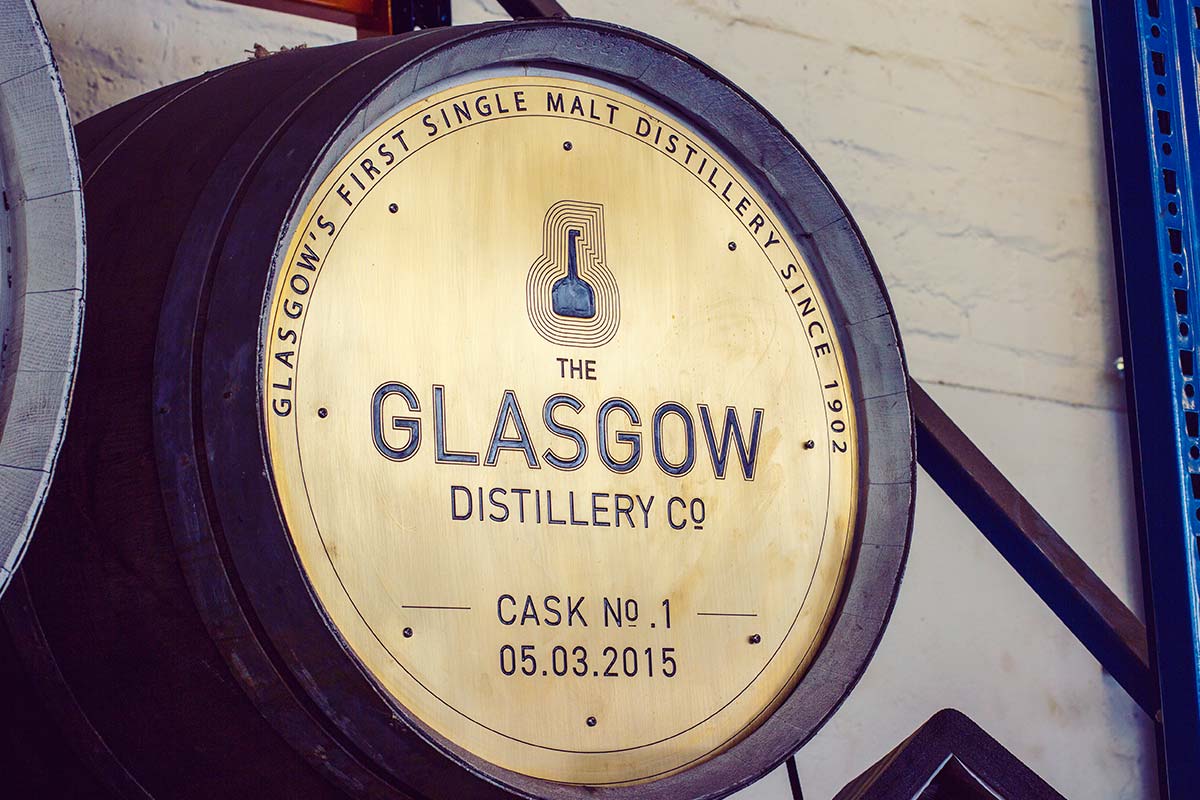
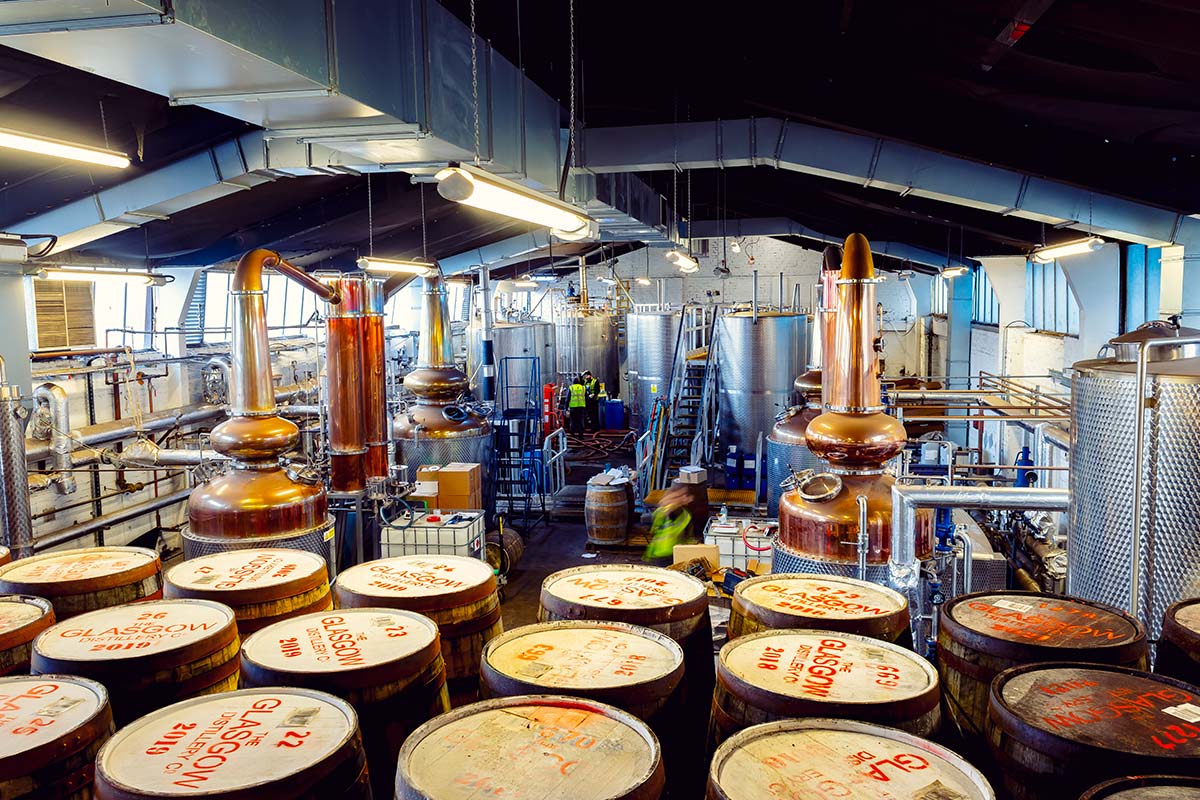
You can learn more about the many great Scottish Gins by visiting the links below.